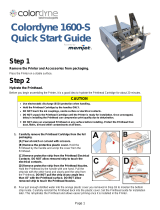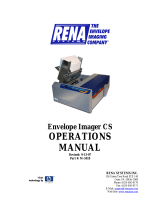
ii ENWW
Printing envelopes and cards . . . . . . . . . . . . . . . . . . . . . . . 5-10
Printing on transparencies . . . . . . . . . . . . . . . . . . . . . . . . . 5-11
Printing on media of user-defined size . . . . . . . . . . . . . . 5-11
Using the rear manual feed . . . . . . . . . . . . . . . . . . . . . . . . 5-12
Using the Toolbox
Printer Status tab . . . . . . . . . . . . . . . . . . . . . . . . . . . . . . . . . . . . 6-1
Information tab . . . . . . . . . . . . . . . . . . . . . . . . . . . . . . . . . . . . . . 6-1
Printer Services tab . . . . . . . . . . . . . . . . . . . . . . . . . . . . . . . . . . 6-2
Maintaining the printer
Cleaning the printer. . . . . . . . . . . . . . . . . . . . . . . . . . . . . . . . . . . 7-1
Maintaining the printheads . . . . . . . . . . . . . . . . . . . . . . . . . . . . . 7-2
Cleaning the printheads . . . . . . . . . . . . . . . . . . . . . . . . . . . . 7-2
Aligning the printheads . . . . . . . . . . . . . . . . . . . . . . . . . . . . 7-3
Replacing the printheads . . . . . . . . . . . . . . . . . . . . . . . . . . . 7-3
Maintaining the ink cartridges . . . . . . . . . . . . . . . . . . . . . . . . . . . 7-4
Troubleshooting
Checking the basics . . . . . . . . . . . . . . . . . . . . . . . . . . . . . . . . . . 8-1
Resolving printer problems . . . . . . . . . . . . . . . . . . . . . . . . . . . . . 8-1
Unexpected printer shutdown. . . . . . . . . . . . . . . . . . . . . . . . 8-2
Printer is not responding (nothing prints) . . . . . . . . . . . . . . . 8-2
Printer light blinks alternating amber and green . . . . . . . . . . 8-3
Printer takes a long time to print. . . . . . . . . . . . . . . . . . . . . . 8-3
Resolving printing problems . . . . . . . . . . . . . . . . . . . . . . . . . . . . 8-4
Blank page printed . . . . . . . . . . . . . . . . . . . . . . . . . . . . . . . . 8-4
Infrared printing does not work . . . . . . . . . . . . . . . . . . . . . . 8-4
Something on the page is missing or incorrect. . . . . . . . . . . 8-5
Placement of the text or graphics is wrong. . . . . . . . . . . . . . 8-5
Poor print quality . . . . . . . . . . . . . . . . . . . . . . . . . . . . . . . . . 8-6
Meaningless characters printed . . . . . . . . . . . . . . . . . . . 8-6
Ink is smearing. . . . . . . . . . . . . . . . . . . . . . . . . . . . . . . . 8-7
Ink is not filling the text or graphics completely . . . . . . . 8-7
Faded or dull-colored output . . . . . . . . . . . . . . . . . . . . . 8-7
Colors are printing as black and white . . . . . . . . . . . . . . 8-8
Colors do not line up properly . . . . . . . . . . . . . . . . . . . . 8-9
Resolving paper-feed problems . . . . . . . . . . . . . . . . . . . . . . . . . 8-9
Print media is jammed . . . . . . . . . . . . . . . . . . . . . . . . . . . . . 8-9
Paper tray cannot be inserted . . . . . . . . . . . . . . . . . . . . . . 8-12
Paper-feed problems . . . . . . . . . . . . . . . . . . . . . . . . . . . . 8-12
EulerUG.book Page ii Monday, July 16, 2001 5:34 PM





















